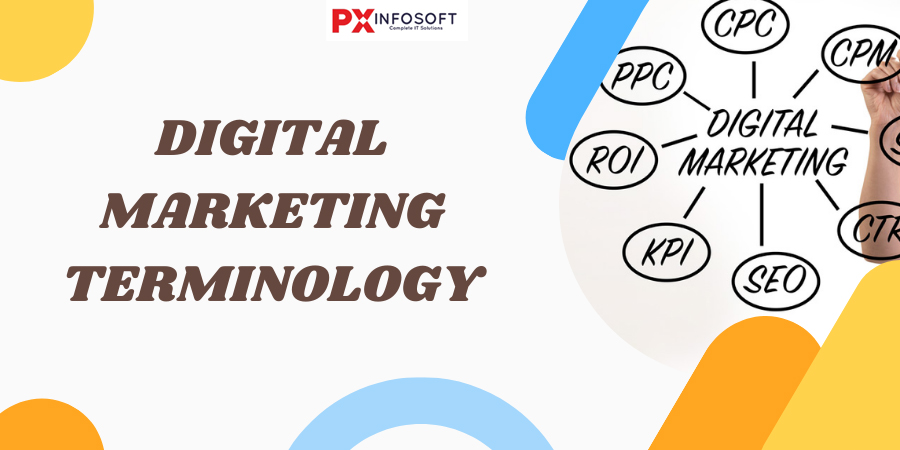In our fast-paced world, digital marketing has evolved from a mere buzzword to the very foundation of every business strategy. Whether you’re a marketing pro or just dipping your toes into the field, the digital marketing landscape can seem like a maze of complex terms and concepts that might feel a bit daunting at first. But don’t hurry! This guide is designed to simplify the key digital marketing terms you’ll need to know as we head into 2025. From SEO and PPC to content marketing and social media strategies, each of these terms is crucial for building a strong online presence. Grasping these concepts will not only enhance your communication with your team but also empower you to make smart decisions that can boost your business. So, if you’re eager to get comfortable with the language of digital marketing, let’s jump into this essential glossary and unravel the terminology together!
A/B Testing
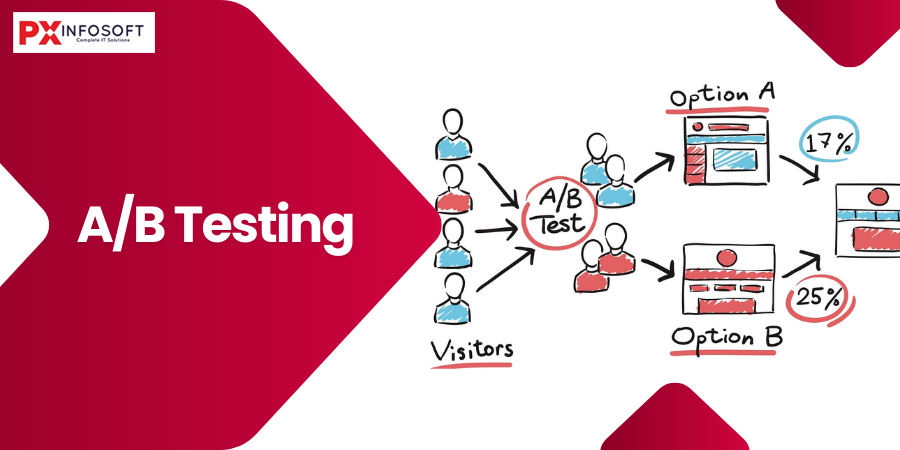
In the ever-changing landscape of digital marketing, making decisions based on data is crucial for fine-tuning campaigns and boosting results. One of the most effective tools in a digital marketer’s arsenal is A/B testing, often called split testing. This technique lets you pit two versions of a webpage, email, or ad against each other to see which one performs better. Essentially, it involves showing two different versions of digital content to a specific audience and measuring their responses to find out which one resonates more. The effectiveness is gauged by looking at the conversion rate. This approach is widely used for testing e-newsletters, email subject lines, social media ads, calls-to-action, and landing page copy to figure out which version is more likely to prompt actions like signing up for a paid membership. So, what exactly is A/B testing, how does it function, and why should it be a part of your digital marketing strategy? Let’s explore the ins and outs!
What is A/B Testing?
A/B testing, often referred to as split testing, is a technique that allows you to compare two different versions (A and B) of a marketing asset—like a landing page, email, or advertisement—to determine which one performs better. The main aim is to leverage data and actual user behavior to figure out what resonates most with your audience and to make enhancements based on those insights.
For instance, if you’re looking to boost the conversion rate of a landing page, you might experiment with two variations: one featuring a red “Buy Now” button and the other showcasing a green “Buy Now” button. By examining which button color drives more conversions, you can fine-tune your page to achieve the best possible results.
How Does A/B Testing Work?
-
Define the Objective: Before starting, you need to define what you are trying to achieve. Are you aiming for more clicks, higher engagement, or increased sales? A clear goal will help you design your test.
-
Create Two Versions: Develop two variations of the element you want to test (e.g., headlines, images, call-to-action buttons). Version A is usually the current version (control), and version B is the new one you’re testing (variant).
-
Split Your Traffic: Direct half of your audience to version A and the other half to version B. The key is to ensure that both versions are shown to a comparable audience so that the results are valid.
-
Measure Results: Collect data on how each version performs based on the predefined objective. Metrics could include click-through rates, conversion rates, or time spent on page.
-
Analyze and Implement: Once you’ve gathered enough data, analyze the results. The version with the best performance should be implemented. You can continue refining your marketing materials by conducting further A/B tests.
Why is A/B Testing Important in Digital Marketing?
A/B testing is incredibly valuable because it allows you to make informed decisions based on real user behavior, rather than assumptions or guesswork. Here are a few reasons why A/B testing is a game-changer in digital marketing.
-
Data-Driven Decisions: Rather than relying on intuition, A/B testing provides concrete data on what works and what doesn’t, allowing you to make evidence-backed decisions.
-
Improved ROI: By continually optimizing your campaigns, websites, and marketing assets, A/B testing helps you boost conversion rates, improve customer engagement, and ultimately, achieve a better return on investment (ROI).
-
Better User Experience: A/B testing helps you identify elements that enhance the user experience, such as intuitive design, compelling headlines, or clear calls to action. A better user experience often leads to higher customer satisfaction and loyalty.
-
Ongoing Optimization: Digital marketing is never “finished.” With A/B testing, you can continually test and refine your campaigns over time, staying ahead of the competition and keeping up with ever-changing consumer preferences.
What Can You A/B Test in Digital Marketing?
A/B testing can be applied to a wide variety of elements in digital marketing. Here are some common things you can test.
-
Landing Pages: Test different headlines, images, CTAs (calls to action), or layouts to determine which combination leads to higher conversions.
-
Emails: You can test subject lines, sender names, email copy, and the design of your email templates. Small tweaks, like changing the subject line, can have a significant impact on open rates.
-
Ad Copy: Whether it’s a Facebook ad, Google ad, or display ad, you can test different versions of the copy, headlines, images, and calls to action to improve click-through rates (CTR).
-
Web Forms: Test the length of forms, the placement of fields, and the wording of calls to action to see which version gets more submissions.
-
Pricing: Test different pricing structures, discount offers, or product bundles to see which results in more purchases or conversions.
Best Practices for A/B Testing
To get the most out of your A/B tests, here are some best practices to follow.
-
Test One Variable at a Time: To ensure the test results are reliable, only test one element at a time. For example, if you’re testing a landing page, don’t change both the headline and the CTA button color at the same time. This ensures you know which variable influenced the result.
-
Ensure Statistical Significance: It’s important to gather enough data for your test to be statistically significant. A small sample size may lead to misleading results. Tools like Google Optimize or Optimizely can help you calculate statistical significance.
-
Use a Sufficient Sample Size: A small sample size can result in inconclusive or inaccurate results. Ensure your test reaches enough people to provide reliable data.
-
Run Tests Continuously: A/B testing is an ongoing process. As customer behavior and market conditions change, continue running tests to optimize your campaigns over time.
-
Avoid Biased Testing: Make sure your audience is randomly split to avoid bias. Both groups (A and B) should represent a similar demographic and behavior pattern.
Tools for A/B Testing
There are many tools available that can help you run A/B tests easily. Some of the most popular tools.
-
Google Optimize: A free tool from Google that allows you to run A/B tests, multivariate tests, and more.
-
Optimizely: A powerful tool that allows marketers to experiment with different digital experiences and optimize conversion rates.
-
VWO (Visual Website Optimizer): A user-friendly tool for running A/B tests and heatmaps to understand how users interact with your website.
-
Unbounce: Best known for A/B testing landing pages, this tool makes it easy to optimize your conversion rates.
Common Mistakes to Avoid in A/B Testing
To get the most accurate and actionable insights from A/B testing, be aware of these common mistakes.
-
Testing for Too Short a Period: A/B tests should run long enough to account for variations in daily traffic patterns. Running a test for too short a time may yield unreliable results.
-
Not Defining Clear Goals: Without clear goals, it’s hard to measure success. Always define what success looks like before starting an A/B test.
-
Making Too Many Changes at Once: If you change too many variables at once, you won’t know which element impacted performance. Stick to testing one variable at a time.
-
Ignoring Statistical Significance: Jumping to conclusions without checking if the results are statistically significant can lead to poor decision-making.
A/B testing is a fantastic way to supercharge your digital marketing game. By continuously experimenting and fine-tuning your campaigns, emails, landing pages, and ads, you can make sure you’re providing the best experience for your users while also achieving top-notch results. Whether your goal is to increase conversions, boost user engagement, or enhance your ROI, A/B testing gives you valuable insights that empower you to make informed, data-driven decisions and keep you ahead in the fast-paced digital world. Incorporating A/B testing into your digital marketing strategy allows you to tap into the power of data, helping you refine your marketing efforts and achieve the best outcomes possible.
Affiliate Marketing
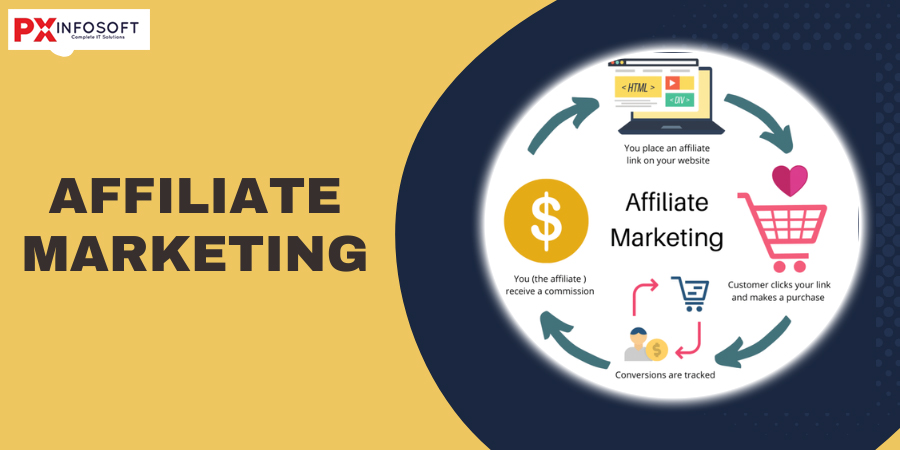
Affiliate marketing is a performance-driven approach where businesses reward outside partners, called affiliates, for bringing traffic or sales to their websites through their marketing efforts. It’s a distinctive digital marketing strategy that fosters collaboration between businesses and affiliates to boost sales, generate leads, or achieve conversions, with affiliates earning commissions for their hard work.
In a nutshell, affiliate marketing creates a win-win situation for everyone involved. The business gains more visibility and sales, the affiliate earns commissions for their promotional efforts, and customers discover relevant products or services through the content shared by affiliates.
How Affiliate Marketing Works
Affiliate marketing typically involves three main parties.
-
The Merchant (Advertiser): This is the business or company that sells the product or service. The merchant has something to promote and is looking for affiliates to help promote and sell it.
-
The Affiliate (Publisher): An affiliate is an individual or business that promotes the merchant’s products or services through various marketing channels. They drive traffic to the merchant’s website via unique tracking links and earn a commission when a sale or action is completed.
-
The Consumer: The consumer is the person who buys the product or takes a desired action, like filling out a form or signing up for a trial, based on the affiliate’s marketing efforts.
In the process:
-
The merchant provides the affiliate with unique tracking links or codes to track the sales or leads.
-
The affiliate markets the merchant’s product using content like blogs, videos, social media posts, etc.
-
When a consumer clicks the affiliate link and makes a purchase or completes an action, the affiliate earns a commission.
Types of Affiliate Marketing Models
-
Pay-per-Sale (PPS): In this model, affiliates earn a commission when a consumer makes a purchase after clicking on their referral link. This is the most common affiliate marketing model, and the commission is typically a percentage of the sale price.
-
Pay-per-Click (PPC): Affiliates earn a commission every time a user clicks on their affiliate link, regardless of whether the user makes a purchase. While this model focuses on traffic generation rather than sales, it can be profitable with enough traffic.
-
Pay-per-Lead (PPL): In this model, affiliates earn commissions when a user takes a specific action, such as filling out a form, signing up for a free trial, or subscribing to a newsletter. The focus is on generating leads, rather than immediate sales.
The Affiliate Marketing Process
-
Product Selection: The merchant chooses the product or service they want to promote.
-
Affiliate Recruitment: The merchant recruits affiliates through affiliate programs or networks. These affiliates have their own methods of promoting the products to their audience.
-
Promotion: Affiliates promote the merchant’s product on their website, blog, YouTube channel, or through social media posts. The affiliate may use content like product reviews, tutorials, banners, and referral links to promote.
-
Tracking: The affiliate links are tracked through unique tracking URLs. This allows the merchant to see which affiliate brought the sale or action and calculate the affiliate’s commission.
-
Payment: After the sale or lead is generated, the affiliate earns a commission. Payments are typically made on a monthly basis or once a certain threshold has been met.
Benefits of Affiliate Marketing
-
Cost-Effective: Affiliate marketing allows businesses to reach a wider audience without spending large sums of money upfront. Since affiliates are paid based on performance, it reduces the risk for businesses.
-
Scalability: The affiliate marketing model is highly scalable. You can recruit an unlimited number of affiliates to promote your products, which can significantly increase your reach.
-
Access to a Larger Audience: Affiliates usually have their own established audience base, whether through blogs, social media, or email lists. This allows businesses to tap into new customer pools they might not otherwise have access to.
-
Reduced Risk: Since affiliate marketing is typically performance-based, businesses only pay for actual sales or leads. This reduces the upfront costs and minimizes the risk compared to other forms of marketing.
-
Flexibility and Diversity: Affiliates use a wide range of promotional methods, from blog posts and email marketing to social media and video content. This variety can help businesses reach diverse segments of the market.
Challenges in Affiliate Marketing
-
Quality Control: Since affiliates are responsible for promoting the products, businesses may not always have complete control over how their products are marketed. Some affiliates might use aggressive or unethical tactics, which could harm the brand’s reputation.
-
Affiliate Fraud: Fraudulent practices, such as fake clicks, false leads, or counterfeit sales, can affect the integrity of an affiliate marketing program. Businesses must ensure they are working with trustworthy affiliates and use fraud detection tools.
-
Managing Affiliate Relationships: Maintaining good relationships with affiliates is crucial for long-term success. Businesses must provide affiliates with the tools, resources, and support they need to succeed in promoting the product.
-
Competition: With affiliate marketing being a low-risk strategy, many businesses use it, which can lead to intense competition between affiliates. This could make it harder for businesses to stand out in crowded niches.
Affiliate Marketing Channels
-
Content Websites and Blogs: Many affiliates run content-rich blogs and websites where they promote products through articles, reviews, comparisons, and lists.
-
Social Media: Influencers and social media marketers often engage in affiliate marketing by sharing product recommendations or links to products through Instagram, YouTube, TikTok, and Facebook.
-
Email Marketing: Some affiliates build email lists and promote products directly to their subscribers. This is effective as email marketing has high conversion rates when done correctly.
-
Paid Advertising: Affiliates sometimes run paid ads (like Google Ads, Facebook Ads) to direct traffic to the merchant’s website. The affiliate earns a commission when the referred customer makes a purchase or takes action.
Tips for Successful Affiliate Marketing
-
Choose the Right Affiliates: Work with affiliates who align with your brand’s values and have an audience that fits your target market.
-
Provide High-Quality Content: The more informative and engaging the affiliate content, the better the chances of converting leads into sales. Offering valuable content increases trust and encourages more purchases.
-
Track and Optimize Performance: Use tools like Google Analytics or affiliate marketing software to track affiliate performance. This will help you understand what strategies are working and where improvements can be made.
-
Offer Attractive Commission Structures: An attractive commission structure can motivate affiliates to work harder to promote your products. Offering tiered or performance-based commissions can further incentivize affiliates to increase their efforts.
-
Maintain Open Communication: Stay in regular contact with your affiliates, providing them with updates, promotional material, and the latest offers. This will help ensure they’re always equipped with the best tools for promotion.
Affiliate marketing stands out as a dynamic and budget-friendly approach in the realm of digital marketing, bringing advantages to both companies and their affiliates. By tapping into the reach and impact of affiliates, businesses can boost their brand visibility, attract more visitors, and ultimately increase sales. Meanwhile, affiliates have the chance to earn commissions from their marketing activities, fostering a win-win relationship. For businesses eager to enhance their digital marketing strategies, affiliate marketing is definitely a model to explore. When done right, it presents a low-risk avenue for growth and sustainable profits.
Brand Positioning
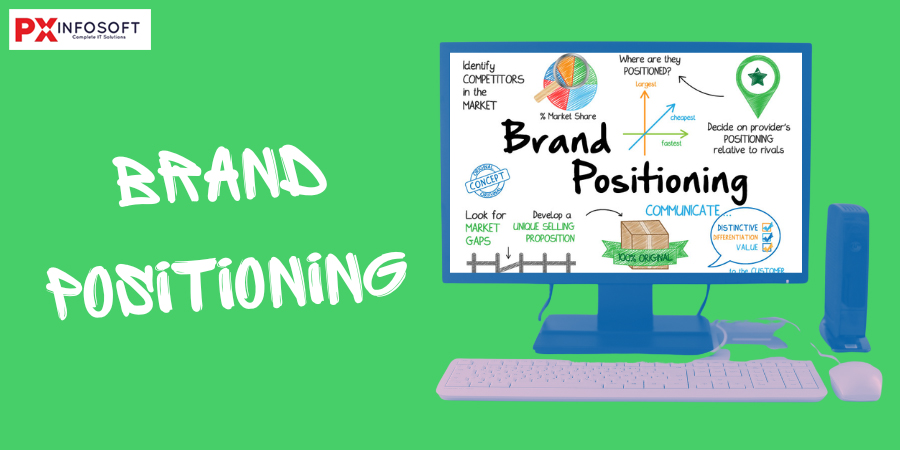
Brand positioning in digital marketing is all about carving out a unique spot for your brand in the minds of your target audience. Imagine it as the impression you want people to have when they encounter your brand online—what makes you different? What distinguishes you from the competition? It’s all about showing the value your brand brings and why it’s the top choice for your customers. In today’s landscape, digital marketing is where most of this positioning happens. Whether it’s through social media, search engines, email, or your website, you need a clear and consistent message that allows your brand to shine and connect with the right audience.
Why Is Brand Positioning Important in Digital Marketing?
- Helps Your Brand Stand Out: The internet is a busy place, and every day, people are hit with a flood of information. If you want your brand to catch their eye, you really have to stand out from the crowd. That’s where effective brand positioning comes in—it helps you pinpoint what sets you apart and why folks should pick you over the competition. Think of it as carving out your own little niche in a bustling marketplace.
- Builds Strong Connections with Customers: When your brand’s positioning truly resonates with your audience, it creates a powerful emotional bond. This bond is crucial because people tend to buy from brands they feel a connection with. A solid positioning strategy in digital marketing can help you engage with your target audience in a way that really matters.
- Creates Consistency Across Channels: Brand positioning is all about making sure that every digital channel you use—be it your website, social media, or email marketing—communicates in a unified voice and conveys the same essential message. This consistency in your messaging helps customers easily identify your brand and grasp what it truly represents.
- Drives Customer Loyalty and Trust: Positioning is key to building a solid brand identity. When your customers have a clear grasp of what your brand stands for and why they can trust it, they’re much more inclined to stick around. And that loyalty? It paves the way for repeat business, referrals, and lasting success.
Steps to Effective Brand Positioning in Digital Marketing
- Know Your Target Audience: Before you can really position your brand, it’s essential to know who you’re speaking to. Take the time to explore your target audience’s demographics, behaviors, interests, pain points, and preferences. Leverage digital tools like Google Analytics, social media insights, and customer surveys to collect valuable data. The better you understand your audience, the more effectively you can tailor your brand to meet their needs.
- Understand Your Competition: Take a moment to really examine your competitors and how they position themselves in the market. How do they showcase their brand? What are their strengths, and where do they miss the mark? Doing this kind of research can help you spot gaps in the market and discover opportunities for your own brand to step in. Competitive analysis is an invaluable asset in digital marketing, as it gives you insight into what strategies are effective and which ones might not be hitting the mark in your industry.
- Define Your Unique Value Proposition (UVP): What sets your brand apart from the rest? That’s your Unique Value Proposition (UVP), and it plays a vital role in how you position yourself in the market. Your UVP tells customers why they should choose you over others and highlights the benefits they’ll gain by partnering with you. Is it your top-notch quality, exceptional customer service, innovative solutions, or competitive pricing? Make sure it’s clear and stands out in your messaging.
- Create a Clear and Consistent Message: Once you’ve nailed down your Unique Value Proposition (UVP), it’s crucial to ensure that your brand message is crystal clear, straightforward, and consistent across all your digital platforms. Whether you’re crafting a blog post, tweeting, sharing an Instagram story, or sending out an email, your message should resonate with the values and benefits you want to highlight about your brand. This kind of consistency helps to foster recognition and trust as time goes on.
- Leverage Digital Marketing Tools and Channels: To really make your brand stand out, it’s important to leverage digital marketing tools and platforms that truly connect with your audience. Think about using content marketing, SEO (Search Engine Optimization), social media marketing, paid ads, and email marketing as your go-to strategies for sharing your message. The key is to find your audience where they already hang out online and gently steer them toward your brand.
- Test and Refine Your Positioning Strategy: Brand positioning isn’t just a set-it-and-forget-it kind of deal. It’s something you need to keep working on over time. Keep an eye on how your positioning strategy is doing by tracking important metrics like engagement, conversion rates, customer feedback, and overall brand sentiment. Stay flexible and be ready to tweak your approach based on the insights you gather. The digital landscape is always changing, and your positioning strategy should adapt right along with it.
Tools for Brand Positioning in Digital Marketing
- Google Analytics: Google Analytics provides valuable insights into how your audience interacts with your website. You can monitor which pages they check out, how long they linger, and what content captures their interest the most. This information allows you to refine your messaging effectively.
- Social Media Insights: Social media platforms like Facebook, Instagram, Twitter, and LinkedIn offer a treasure trove of insights about your audience. They’re fantastic tools for understanding how people view your brand, what really connects with your followers, and where there’s room for growth.
- SEO Tools (SEMrush, Ahrefs): SEO tools are fantastic for uncovering which keywords your competitors are using and how your own website stacks up in search rankings. With this valuable information, you can fine-tune your online presence and make sure your content resonates with the right audience.
- Survey Tools (SurveyMonkey, Google Forms): Conducting surveys gives you direct feedback from your audience about how they perceive your brand. Understanding customer sentiment can be a goldmine for adjusting your positioning strategy.
Common Mistakes to Avoid in Brand Positioning
-
Being Too Vague
If your brand’s message isn’t clear, people will struggle to understand what you stand for. Avoid being too broad or generic in your positioning. Focus on specific value that resonates with your target audience. -
Inconsistency Across Channels
If your brand’s message changes drastically from one platform to another, it will confuse your audience. Keep your positioning consistent across all digital channels. -
Ignoring the Audience’s Needs
Brand positioning must be audience-focused. Don’t get caught up in what you think your brand should be—listen to your audience and adjust your positioning based on their needs and feedback. -
Neglecting the Competitive Landscape
Failing to understand your competitors can put you at a disadvantage. Knowing where your brand fits within the competitive landscape allows you to position it effectively against others in the market.
Brand positioning in digital marketing is crucial for your brand’s success in the online landscape. It’s really about clarifying what your brand represents, identifying your target audience, and highlighting what sets you apart from the competition. By utilizing the right tools, gaining a solid understanding of your audience, and crafting a clear message, you can establish a robust and consistent brand presence across all digital platforms. As you continue to refine and adjust your positioning over time, you’ll foster stronger connections with your customers and set the stage for sustainable growth.
Content Strategy
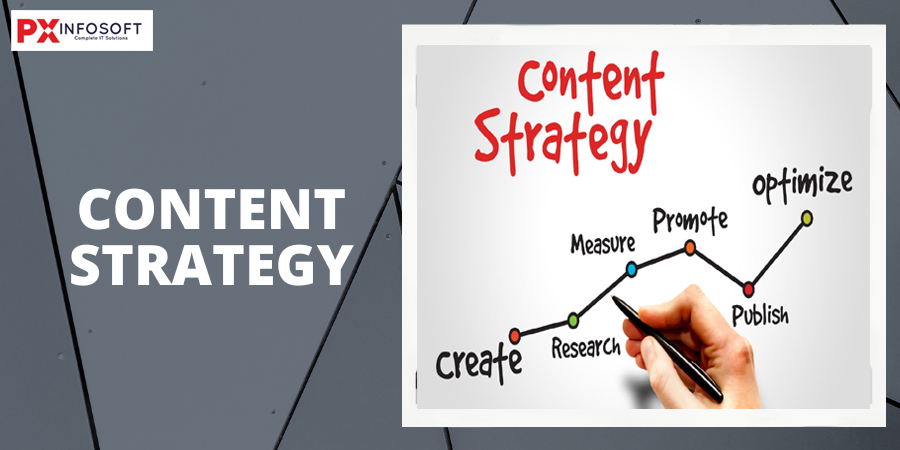
In our fast-paced digital landscape, content isn’t just a collection of words; it’s the foundation of a successful marketing strategy. A content strategy in digital marketing is about much more than just churning out posts. It’s about developing a thoughtful plan that not only aligns with your business objectives but also resonates with your audience on a deeper level. Whether your aim is to enhance your brand, boost sales, or attract more visitors to your website, a well-crafted content strategy will help you navigate the intricate world of digital marketing.
What is Content Strategy?
Content strategy, in simple terms, is all about planning, creating, delivering, and managing content—whether it’s text, images, videos, or anything else that connects with your audience. The goal is to ensure that what you share is not only relevant and consistent but also resonates with your audience’s needs and interests. When you have a solid content strategy in place, you can foster trust, educate your audience, and ultimately turn them into loyal customers.
Why is Content Strategy Important?
With the amount of digital content being created every minute, it can be easy for your content to get lost in the noise. Here’s why a solid strategy is crucial:
-
Builds Brand Awareness: Good content doesn’t just sell a product or service; it tells a story that resonates with your audience. Over time, this helps build your brand’s reputation and increases its visibility.
-
Enhances Engagement: People connect with content that adds value. Whether it’s a helpful blog post, a fun video, or a thoughtful social media update, content that engages users will keep them coming back.
-
Boosts SEO Rankings: Search engines love quality, relevant content. When you consistently create content that answers your audience’s questions and adds value, you improve your chances of ranking higher on Google and other search engines.
-
Drives Conversions: At the end of the day, content is a tool to drive sales. Whether you want someone to sign up for your newsletter or make a purchase, content guides potential customers down the conversion funnel.
Steps to Create a Winning Content Strategy
Creating a content strategy doesn’t need to be intimidating. Here are the key steps you can follow to develop a strategy that works for your brand:
1. Define Your Goals
Before you begin creating content, ask yourself: What do you want to achieve? Common goals might include:
- Increasing brand awareness
- Generating leads
- Growing an email list
- Boosting sales
- Improving customer loyalty
Having clear goals will help you stay focused and ensure that your content aligns with your business objectives.
2. Know Your Audience
One of the most critical parts of a content strategy is understanding your target audience. You need to know:
- Who they are (age, gender, location, etc.)
- What their pain points are
- What questions they need answers to
- Where they hang out online (social media, forums, etc.)
Create buyer personas—detailed profiles of your ideal customers—to better understand their needs, interests, and how they prefer to consume content. This knowledge helps you create content that resonates with them.
3. Choose Your Content Types
Not all content is created equal. Different types of content can appeal to different audiences, and the format you choose should be tailored to your goals. Some content types include:
- Blogs: Great for SEO and educating your audience.
- Videos: Highly engaging and ideal for explaining complex concepts or showing product demos.
- Infographics: Visually appealing and great for simplifying data.
- Podcasts: Perfect for reaching audiences who prefer audio content.
- Social Media Posts: Short, engaging content that drives interaction.
Be sure to choose a mix of content that aligns with your audience’s preferences and the goals you’ve set.
4. Content Creation and Planning
Now that you know what content you want to create, it’s time to get to work. Make sure you:
- Develop high-quality content that provides value.
- Create a content calendar to ensure consistency.
- Tailor content to your different platforms and audiences.
A content calendar helps you stay organized and ensures you’re not scrambling for ideas last-minute. It also helps you track when and where content will be published, which is essential for managing multiple platforms.
5. Distribute Your Content
Creating great content is only half the battle. You also need to get it in front of your audience. This involves distribution across various channels:
- Social Media: Share your content on platforms like Facebook, Instagram, LinkedIn, and Twitter.
- Email Newsletters: Directly send valuable content to your subscribers.
- Paid Advertising: Use platforms like Google Ads or social media ads to promote your content.
- Influencer Partnerships: Collaborate with influencers to extend your reach.
6. Measure Your Success
Once your content is out there, it’s time to evaluate its performance. Use analytics tools to measure:
- Traffic: How many people are visiting your website from your content?
- Engagement: Are people liking, commenting, and sharing your posts?
- Conversion Rates: Are people taking the desired actions (purchasing, signing up, etc.)?
Regularly analyze these metrics and adjust your strategy as needed. It’s important to learn from both successes and failures to continually improve your content.
Key Tips for a Successful Content Strategy
- Consistency is Key: Regular posting and content updates help keep your brand visible and relevant.
- Focus on Quality Over Quantity: Don’t focus on pumping out content just for the sake of it. Quality content that provides value is more important.
- Stay Authentic: Be true to your brand’s voice and values. Authenticity fosters trust with your audience.
- Repurpose Content: Don’t be afraid to repurpose content across different platforms and formats to extend its life and reach.
- SEO Optimization: Optimize your content for search engines to increase visibility and drive organic traffic.
A solid content strategy is essential for any digital marketing campaign that wants to succeed. When you take the time to plan, create, and share content that resonates with your audience’s needs, you not only earn their trust but also bring them one step closer to becoming loyal customers Continuously fine-tune your strategy using data and feedback, and your content will pave the way for lasting success in the digital world. Keep in mind that content goes beyond just being marketing material—it’s a powerful tool for building relationships with your audience and guiding them through their journey with your brand.
Conversion Rate
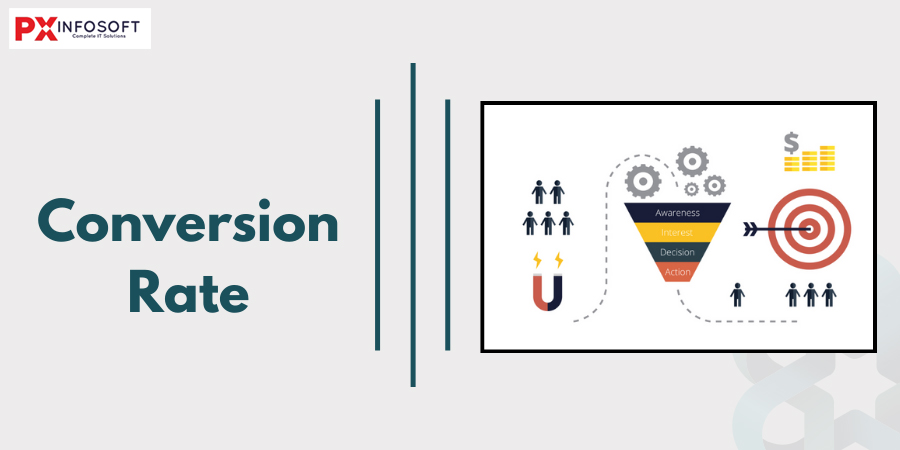
Conversion Rate is one of the most important metrics in the world of digital marketing. Essentially, it gauges how effective your marketing strategies are by revealing the percentage of visitors who take a desired action on your website or digital platform. This could mean making a purchase, filling out a form, subscribing to a newsletter, or downloading a resource. Ultimately, conversions are what fuel success in your digital marketing campaigns.
However, conversion rates are more than just cold, hard numbers—they narrate the story of how well your website, product, or service connects with your audience. A higher conversion rate indicates that your marketing efforts are hitting the mark!
What is Conversion Rate?
The conversion rate is calculated using a simple formula:
Conversion Rate = (Number of Conversions ÷ Total Number of Visitors) × 100
For example, if you had 1,000 visitors on your website and 50 of them made a purchase, your conversion rate would be:
(50 ÷ 1000) × 100 = 5%
That means 5% of visitors turned into customers. While the goal is often to increase this percentage, it’s important to understand that what constitutes a conversion varies depending on your business objectives.
Why is Conversion Rate Important?
In the world of digital marketing, your main aim is to inspire people to take action—be it making a purchase, signing up for a service, or interacting with your content. The conversion rate serves as a clear indicator of how effectively you’re reaching that goal. So, why does it matter?
- It shows effectiveness: A high conversion rate indicates that your messaging, content, and calls to action are working well. If it’s low, you need to reevaluate your strategy.
- It helps optimize ROI: Instead of spending more money to acquire more visitors, focusing on improving your conversion rate can lead to better returns on your investment.
- It identifies areas for improvement: A poor conversion rate signals areas of friction, such as a complicated checkout process or confusing website design, which may need optimization.
Types of Conversions in Digital Marketing
Conversions can mean different things based on your goals. Here are some common types:
- Sales: This is the ultimate goal for e-commerce businesses. A visitor turning into a paying customer is a clear conversion.
- Leads: For service-based businesses or SaaS companies, a conversion may not be a sale but a lead—such as filling out a contact form, subscribing to a newsletter, or requesting a demo.
- Sign-Ups: Many companies aim to convert visitors into subscribers. This can be for a newsletter, free trial, or membership.
- Downloads: In content marketing, getting users to download an eBook, white paper, or app is a type of conversion.
- Engagement: Sometimes, the desired conversion is not immediate. You might want people to comment on a blog post, like your social media posts, or spend a certain amount of time on your site.
Factors That Influence Conversion Rate
There are many elements that influence the success of your conversion rate. Some of the key factors include:
- User Experience (UX): Having a clean and easy-to-navigate website or app is super important. If users have a hard time finding what they’re looking for, they’re probably going to bounce without taking action. So, it’s crucial to ensure your site is mobile-friendly, loads quickly, and looks great!
- Website Design and Layout: Your website’s design is crucial in steering users toward making conversions. When you have a clean layout with straightforward calls to action (CTAs), it becomes much easier for users to understand their next steps.
- Landing Pages: Effective landing pages are optimized for conversions. They should align with the promise made in your ad or email campaign and focus on one clear goal.
- Call to Action (CTA): A powerful call to action (CTA) can really boost your conversions. It should grab attention and be crystal clear, guiding the user on what to do next—like saying “Buy Now,” “Download Your Free Guide,” or “Get Started.”
- Trust Signals: Security badges, customer reviews, testimonials, and clear return policies help users feel more confident in their decision, which can improve conversion rates.
- Speed: Users expect websites to load quickly. If your website is slow, visitors are likely to leave before completing a conversion.
- Personalization: Tailoring your content and offers based on a visitor’s behavior, location, or interests can significantly improve conversion rates. Personalized experiences make users feel like the content is specifically for them.
- Traffic Quality: The quality of the traffic you bring to your site is really important. When visitors are truly interested in what you have to offer, they’re much more likely to make a purchase compared to those random visitors who don’t really connect with your product or service.
How to Improve Conversion Rate
Improving your conversion rate is a continual process. Here are some tactics you can use:
- A/B Testing: Explore various versions of your website, landing pages, and ads. Consider tweaking the wording on your call-to-action, trying out different images, or adjusting the layout. Check which version gets better results and use those insights to enhance your future designs.
- Optimize the Checkout Process: If you’re in e-commerce, the checkout process must be simple and fast. Reduce the number of steps, allow for guest checkouts, and provide multiple payment options.
- Use High-Quality Visuals: A picture really can say a thousand words! So, make sure to use high-quality images or videos to highlight your products or services. They not only help establish trust but also make the whole experience much more engaging.
- Leverage Social Proof: Make sure to showcase testimonials, reviews, and case studies in a prominent way. This helps to reassure visitors that other people have put their trust in your product and have had great experiences with it.
- Improve Mobile Experience: With so many folks shopping and browsing on their mobile devices these days, it’s super important to make sure your site is mobile-friendly. If your site doesn’t adapt well to smaller screens, you could be missing out on a lot of potential sales.
- Offer Incentives: Offering discounts, free trials, or bonuses can nudge visitors into taking the final step. Be clear about the value they’ll get.
- Focus on Content Quality: Content is a key part of your marketing funnel. Make sure your content is valuable, informative, and relevant to your audience’s needs.
Your conversion rate is a key metric that gives you insight into how effectively your digital marketing campaigns are performing. It’s not just about drawing in visitors; it’s about converting those visitors into customers or leads. By enhancing user experience, experimenting with your campaigns, and honing in on strategies that resonate with your audience, you can boost your conversion rates and enjoy greater returns on your marketing investments. In the end, a strong conversion rate indicates that you’re not only connecting with the right people but also delivering the right value at the right moment. So, take the time to fine-tune your digital marketing strategies, and you’ll start seeing improved results before you know it!
Cost Per Acquisition (CPA)
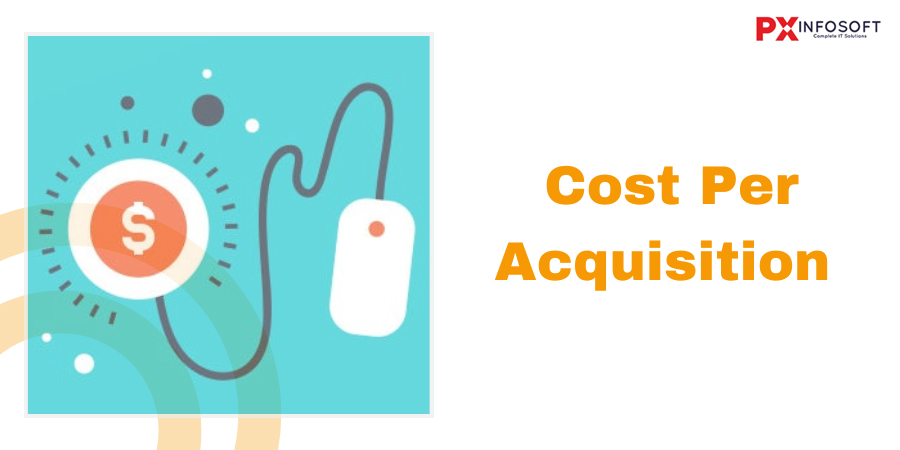
When you’re diving into a digital marketing campaign, one of the key things you really need to keep an eye on is how much it actually costs to bring in a new customer. That’s where Cost Per Acquisition (CPA) steps in. To put it simply, CPA is a metric that helps you figure out how much money you’re spending to acquire just one customer through your marketing efforts. Think of it as a report card for your marketing strategy, giving you insight into whether your approach is financially sound. In the world of digital marketing, businesses rely on CPA to gauge the cost of turning leads—those interested folks—into actual paying customers.
How Is CPA Calculated?
Figuring out your CPA is actually quite simple. Just add up all the money you’ve spent on your marketing campaign—this includes everything from ads and content creation to social media—and then divide that by the total number of customers you’ve brought in from those efforts.
Here’s the formula:
CPA = Total Marketing Spend ÷ Number of Customers Acquired
For example, if you spent ₹1,000 on a digital ad campaign and ended up acquiring 50 new customers, your CPA would be ₹20 (₹1,000 ÷ 50 = ₹20). That means you spent ₹20 to acquire each customer through that campaign.
Why is CPA Important?
- Budget Efficiency: CPA is a great tool for understanding whether you’re getting a solid return on your marketing investment. If you’re shelling out more to bring in a customer than what that customer actually brings to your business, then it’s clear your strategy needs some tweaking to work better.
- Optimizing Campaigns: If your CPA is running a bit high, don’t worry! You can take this info and make some adjustments to fine-tune your campaigns. Perhaps it’s time to reach out to a different audience, switch up your keywords, or even rethink how you showcase your offer.
- Measuring Profitability: The CPA is a fantastic way to gauge just how effective your marketing strategies are. If you’re spending less to acquire a customer than what they’re worth over their lifetime (that’s the LTV), then you’re definitely heading in the right direction with your business!
Different Types of CPA Models
In digital marketing, you might come across a few different ways to structure your CPA. The two most common ones are:
- Cost Per Click (CPC): This is the spot where you shell out money every time someone clicks on your ad. While it’s not quite the same as CPA, you’ll often hear it mentioned in similar discussions. In this case, you’re not paying for a confirmed customer, just for potential leads. Still, it’s an important metric to keep an eye on!
- Cost Per Action (CPA):
This model revolves around paying for specific actions, such as filling out a form, signing up for a newsletter, or making a purchase. It brings you closer to the concept of acquiring a customer because it’s linked to measurable actions that clearly indicate intent.
Factors Affecting CPA
Several factors can influence your CPA, including:
- Target Audience: If you’re aiming for a really competitive market, you might find that your CPA is on the higher side since there are more brands vying for the same audience.
- Ad Quality and Relevance: The more engaging and relevant your ad is for your audience, the higher the chances they’ll take the action you want, which can help reduce your CPA.
- Marketing Channels: The platform or channel you choose for your campaign plays a significant role too. Take Facebook ads or Google search ads, for instance; the cost per acquisition (CPA) can vary based on your target audience and how effectively the campaign is optimized.
- Sales Funnel Efficiency: If your sales funnel isn’t running smoothly—like if there are too many obstacles between a potential customer spotting your ad and actually making a purchase—then you might see your cost per acquisition (CPA) go up. On the flip side, a more streamlined funnel can help bring that CPA down.
How to Lower Your CPA
- Improve Ad Targeting: The more precise you are about who sees your ads, the better your chances of converting them into customers. This involves honing in on your audience and targeting those who are most likely to make a purchase from you.
- A/B Testing: Take the time to run A/B tests on your ads, landing pages, and offers to see what really clicks with your audience. Even minor tweaks in your copy or design can make a big difference, boosting your conversions and lowering your cost per acquisition.
- Optimize Landing Pages: Your landing page is the first place people see after they click on your ad. If it’s not set up just right, you might lose visitors before they even take action. Make sure your page loads fast, features a clear call-to-action, and aligns with the ad that brought them there.
- Remarketing: If someone checked out your website but didn’t end up making a purchase, they’re perfect candidates for remarketing. By giving them a gentle nudge about your offer, you can usually reduce your cost per acquisition and boost those conversion rates.
- Improve Offer Value: Sometimes, adjusting your offer can lead to more conversions. Whether it’s a discount, limited-time offer, or a bonus, make your offer more irresistible to potential customers.
CPA vs. Other Metrics
While CPA is definitely a valuable metric, it’s crucial to remember that it’s not the sole focus in digital marketing. Other important metrics, such as Customer Lifetime Value (LTV), Return on Investment (ROI), and Conversion Rate, also significantly contribute to measuring the overall success of your campaigns.
- CPA vs. LTV: While CPA gives you a clear picture of what it costs to bring in a customer, LTV reveals the true value of each customer over time. Ideally, you want your CPA to be significantly lower than your LTV, which means you’re actually turning a profit from your customers.
- CPA vs. ROI: ROI helps you measure the profitability of your campaign. A low CPA is great, but if you’re not getting a good return on that investment, you might need to rethink your strategy.
Cost Per Acquisition (CPA) is a key player in the world of digital marketing, and for good reason—it has a direct effect on how profitable your campaigns can be. When you take the time to understand and optimize your CPA, you’re setting yourself up to make smarter choices about where to spend your marketing dollars, tweak your ads, and ultimately bring in customers without breaking the bank. It’s all about finding that sweet spot between what you’re spending and the revenue you’re bringing in, ensuring your marketing efforts are as efficient and effective as they can be. By keeping a close eye on your CPA and consistently working to improve it, you’ll be on your way to building more sustainable and profitable marketing campaigns for the long haul.
Conclusion
As we head into 2025, it’s crucial to get a grip on the key digital marketing terms if you want to stay ahead in this fast-changing digital world. Whether you’re a marketing pro or just starting out, getting familiar with concepts like A/B testing, affiliate marketing, brand positioning, content strategy, conversion rates, and cost per acquisition will give you the tools you need to create more effective, data-driven campaigns. By weaving these strategies into your marketing efforts, you’ll be in a stronger position to connect with your audience, streamline your processes, and drive real business growth. Keep yourself updated, keep trying new things, and always refine your approach to ensure you thrive in the digital marketing arena!



